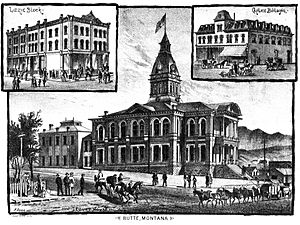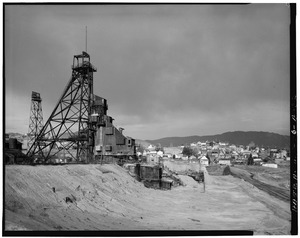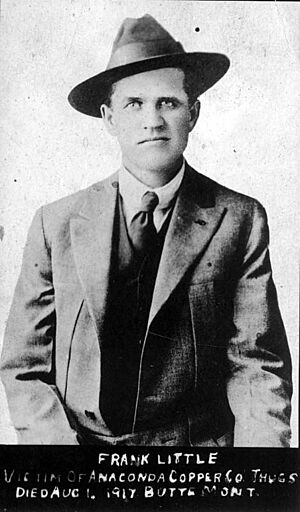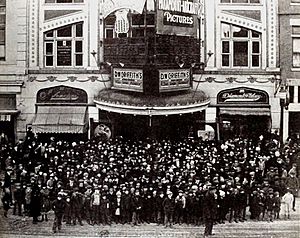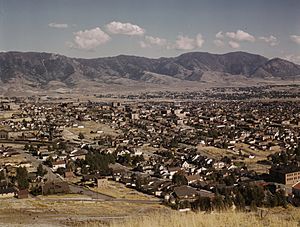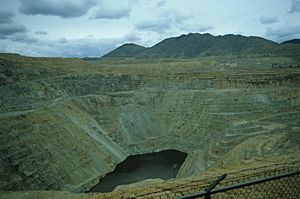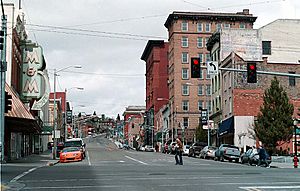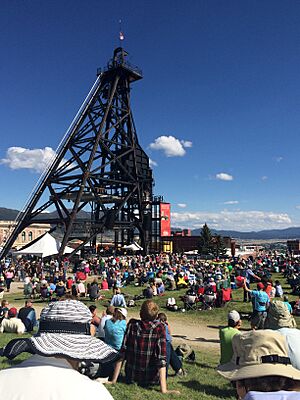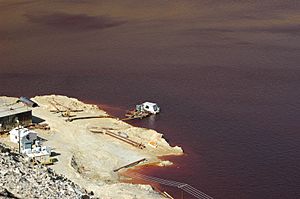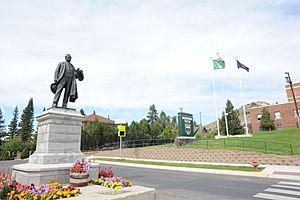Butte, Montana facts for kids
Quick facts for kids
Butte
|
|||
|---|---|---|---|
|
Consolidated city-county
|
|||
| Butte-Silver Bow | |||
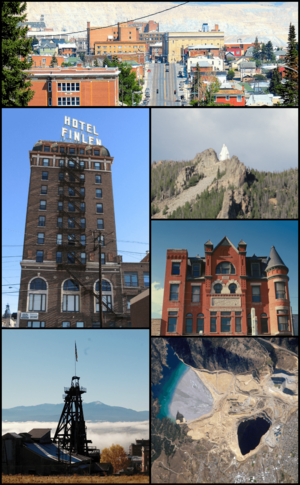
Clockwise, left to right: view of uptown Butte from west; Our Lady of the Rockies; Curtis Music Hall; aerial view of the Berkeley Pit; mine headframe; and the Finlen Hotel
|
|||
|
|||
| Nickname(s):
Butte America
|
|||
| Motto(s):
The Richest Hill on Earth
|
|||
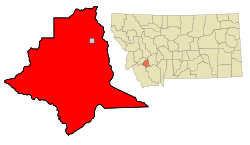
Map of Silver Bow County showing the city of Butte in red and Walkerville in gray
|
|||
| Country | United States | ||
| State | Montana | ||
| County | Silver Bow | ||
| Settled | 1864 | ||
| Area | |||
| • Total | 716.34 sq mi (1,855.32 km2) | ||
| • Land | 715.76 sq mi (1,853.80 km2) | ||
| • Water | 0.59 sq mi (1.52 km2) | ||
| Elevation | 5,538 ft (1,688 m) | ||
| Population
(2020)
|
|||
| • Total | 34,494 | ||
| • Density | 48.19/sq mi (18.61/km2) | ||
| Time zone | UTC−7 (MST) | ||
| • Summer (DST) | UTC−6 (MDT) | ||
| ZIP code |
59701, 59702, 59703, 59707, 59750
|
||
| Area code(s) | 406 | ||
| FIPS code | 30-11397 | ||
| GNIS feature ID | 2409651 | ||
Butte (pronounced BEWT) is a special kind of city in Montana, United States. It's called a consolidated city-county, which means the city and county governments work together as one. This happened in 1977. Butte is the main city in Silver Bow County.
The city covers a large area, about 718 square miles. In 2020, about 34,494 people lived there, making it Montana's fifth-largest city. You can fly to Butte through Bert Mooney Airport.
Butte started in 1864 as a small camp where people looked for valuable metals. It's located high up in the Rocky Mountains, right on the Continental Divide. In the late 1800s, Butte grew very quickly. It became Montana's first big industrial city. During its busiest time, it was one of the largest "boomtowns" in the American West, famous for its copper mines.
Many people from other countries came to Butte for mining jobs. People from Asia and Europe, especially Ireland, moved here. Today, Butte has the largest number of Irish Americans per person of any city in the U.S.
Butte's mining history also led to important events. Workers formed groups called labor unions to fight for better conditions. One famous event was the 1914 worker protests. Even though the Anaconda Copper Mining Company was very powerful, Butte was never a "company town" where one company controlled everything. A sad event was the 1917 Speculator Mine disaster, the biggest mining accident in hard rock mining history.
Over time, Butte's mines produced a huge amount of valuable metals, worth over $48 billion. However, this mining also caused environmental problems. The upper Clark Fork River, which starts in Butte, is now the largest Superfund site in the country. Butte is also home to the Berkeley Pit, a large former mine that became a polluted lake.
Since the late 1900s, groups like the EPA have worked to clean up these areas. People in Butte are also working to save and share the city's unique history. The city's Uptown Historic District is a National Historic Landmark District, meaning it has many important old buildings. Butte is also home to Montana Technological University, a public university focused on engineering and technology.
Contents
History of Butte
Early Days and New Arrivals
Butte began as a mining camp in the early 1860s. The city sits in a natural bowl in the Rockies, called the Silver Bow Creek Valley. In 1874, William L. Farlin started the Asteroid Mine. This mine attracted many people looking for gold and silver.
Workers came from all over the world. They arrived from places like Cornwall (England), Ireland, Wales, Lebanon, Canada, Finland, Austria, Italy, China, Montenegro, and Mexico. These groups often lived in their own neighborhoods. Young men in these areas sometimes formed groups to protect their turf and socialize.
Many Chinese immigrants started businesses, creating a Chinatown in Butte. However, the Chinese Exclusion Act of 1882 stopped more Chinese people from coming. There were also anti-Chinese feelings, and some groups tried to boycott Chinese-owned businesses. But the Chinese business owners fought back in court and won. You can learn more about the history of Chinese immigrants in Butte at the Mai Wah Museum.
Breweries, which make beer, first opened in Butte in the 1870s. German immigrants often ran these businesses. The breweries always hired union workers. Many different groups in Butte, including children, enjoyed the local beers.
Mining Grows Big
In the late 1800s, there was a huge demand for copper. This was because new technologies, like electric power, needed a lot of copper. Powerful business leaders, known as the "Copper Kings," fought to control Butte's mining wealth. These kings included William A. Clark, Marcus Daly, James Andrew Murray, and F. Augustus Heinze.
The Anaconda Copper Mining Company started in 1881. Marcus Daly bought a small mine called the Anaconda. He noticed a lot of high-quality copper ore there. Daly bought the Anaconda mine himself and got help from George Hearst, a mining leader from San Francisco. Soon, huge amounts of copper were found, and Daly became very rich. He bought other mines nearby and built a "smelter" (a factory that separates metal from ore) in Anaconda, Montana. He connected it to Butte by railway. Eventually, the Anaconda Company owned almost all the mines on Butte Hill.
Between 1884 and 1888, W. A. Clark built the Copper King Mansion in Butte. In 1899, he also bought Columbia Gardens, a small park he turned into a fun amusement park. It had a roller coaster and a lake for swimming. Clark wanted the park to be a place where families could escape the polluted air from the mines.
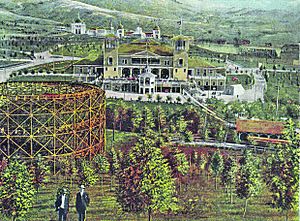
Butte grew very fast. In 1889, one survey said Butte had become the "first mining camp of the world." It was the most populated city in Montana, with 25,000 people. In 1888 alone, Butte's mines produced $23 million worth of ore.
By 1910, Butte was the biggest producer of copper in North America. It was almost as productive as South Africa. The city also found millions of ounces of silver and thousands of ounces of gold. Because of all this metal, Butte was called "The Richest Hill on Earth."
With so many miners working in dangerous conditions, Butte became a center for labor unions. It was known as "the Gibraltar of Unionism." By 1885, about 1,800 workers were part of a union. This union became the Butte Miners' Union (BMU). The BMU helped other mining towns and even sent money to support miners in Idaho.
Miners worried about powerful mine owners. In 1893, about 40 delegates from mining camps met in Butte. They created the Western Federation of Miners (WFM) to organize miners across the West. The Butte Miners' Union became the first local chapter of the WFM.
Anaconda Copper and Worker Unrest
In 1899, the Amalgamated Copper Mining Company was formed, which later became the Anaconda Copper Mining Company (ACM). By the 1920s, Anaconda controlled almost all the mines in Butte. From about 1900 to 1917, Butte also had strong Socialist political ideas.
Butte was known as "one of the most solid union cities in America." After 1905, it became a hub for the Industrial Workers of the World (IWW), also known as the "Wobblies." There was a lot of competition between these groups and the WFM. This led to worker protests in 1914. After this, mine owners stopped recognizing the unions.
The Anaconda Company tried to offer programs to workers. But many conflicts still happened between workers, organizers, and the company. This included the killing of IWW leader Frank Little in 1917. In 1920, company guards shot striking workers in what was called the Anaconda Road Massacre.
A terrible fire started deep underground in the Granite Mountain mine on June 8, 1917. Flames, smoke, and poisonous gas spread through the tunnels. Many miners died trying to escape. Rescue workers tried to help, but the air became toxic. The disaster killed 168 people. It remains the largest hard rock mining accident in history. The Granite Mountain Memorial in Butte remembers those who died.
After the disaster, protests and strikes began. About 15,000 workers left their jobs. The U.S. National Guard had to come to Butte six times between 1914 and 1920 to keep order. Copper production from Butte's mines reached its highest point in 1917, then slowly went down.
In 1919, Margaret Jane Steele Rozsa, a women's rights activist, became a food inspector in Butte. She worked to make sure food prices were fair and helped soldiers who had served in World War I. In 1921, she became the city's first female prohibition inspector.
Open-Pit Mining Era
Worker disputes continued through the 1920s and 1930s. There were several strikes and protests. In 1937, the city's streetcar system was replaced by buses. After the 1920s, the Anaconda Company started to do less underground mining in Butte. This was because it was very hard work, and there was competition from other mines. So, Anaconda started using open pit mining methods in Butte.
Since the 1950s, big changes have happened in Butte. Anaconda started open-pit mining. There were also many fires in Butte's business area in the 1970s. Mining eventually stopped in 1983. Butte then looked for new ways to create jobs. Cleaning up the environment, especially at the Superfund site, has created many jobs.
Thousands of homes in areas like Meaderville were destroyed to make way for the Berkeley Pit. This huge open-pit copper mine opened in 1954. It grew so large that it started to take over the Columbia Gardens amusement park. After the park burned down in 1973, another pit, the Continental Pit, was dug there.
In 1977, ARCO (Atlantic Richfield Company) bought Anaconda. Three years later, they started closing mines because metal prices were low. In 1983, all mining in the Berkeley Pit stopped. When mining stopped, the water pumps in nearby mines were turned off. This caused the Berkeley Pit to fill with very acidic water full of toxic metals.
Anaconda stopped mining at the Continental Pit in 1983. But Montana Resources LLP bought it and reopened it in 1986. They stopped mining in 2000 but started again in 2003.
From 1880 to 2005, Butte's mines produced huge amounts of copper, zinc, manganese, lead, molybdenum, silver, and gold.
Butte in the 21st Century
Today, 14 headframes (the structures above mine shafts) still stand in Butte. The city also has thousands of historic buildings from its boom times. Many buildings in Uptown Butte are old-fashioned, and some are empty. Efforts to save these historic buildings began in the late 1990s.
Like many old industrial cities, Butte now relies more on tourism and services, especially healthcare. St. James Hospital in Butte has the only major trauma center in Southwest Montana. Many areas near the old mines show signs of decay. But new investors and cleanup efforts are helping to restore properties in Uptown Butte. This historic district is one of the largest in the U.S.
Even now, environmental problems remain from over a century of mining. Arsenic and heavy metals like lead are found in high amounts in some areas. In the 1990s, the tap water was sometimes unsafe to drink. But in the 2000s, millions of dollars were spent to improve the water system. Environmental research and cleanup have helped the local economy. In the late 1990s, Butte was named an All-America City.
Butte's Geography
Butte-Silver Bow covers about 716 square miles. Most of this is land, with a small amount of water. The city is located right on the Continental Divide. This means that almost every highway leaving Butte crosses this important line.
The city got its name from a nearby landform called Big Butte. Butte's city landscape is unique because mining structures, like headframes, are visible right within residential areas.
 |
Deer Lodge | Helena |  |
|
| Anaconda | Bozeman | |||
| Dillon |
City Views
Neighborhoods
Butte's mining history brought a lot of wealth to the city. This led to beautiful and fancy homes and buildings, especially in the Uptown area. Uptown is on a steep hillside on the northwest side of town. It has many grand Victorian homes and Queen Anne style cottages built in the late 1800s. Some of Butte's colorful "painted ladies" homes were even featured in a book.
Butte's South district is at a lower elevation. Historically, it was home to working-class neighborhoods. Gold mines were first in South Butte before it was planned for the Union Pacific Railroad in 1881.
The growth of the Anaconda Company in the 1960s and 1970s destroyed some of Butte's old neighborhoods. These included the East Side, Dublin Gulch, Meaderville, and Chinatown. The St. Mary's section, next to Uptown, included the Dublin Gulch (an area for Irish immigrants) and Corktown neighborhoods. It's named after the Roman Catholic church there, which was known as the "miner's church."
Climate
Butte has a cold, dry climate. Winters are long and cold, with January averaging 20 degrees Fahrenheit. It often gets below 0 degrees Fahrenheit. Summers are short, with warm days and cool nights. July averages 63.6 degrees Fahrenheit. Butte doesn't get a lot of rain or snow, and most of it falls in the spring.
The coldest month ever recorded was January 1937. The coldest temperature ever was -52 degrees Fahrenheit, recorded in February 1933 and December 1983. The hottest day was July 22, 1931, reaching 100 degrees Fahrenheit.
| Climate data for Butte, Montana (Bert Mooney Airport), 1991–2020 normals, extremes 1894–present | |||||||||||||
|---|---|---|---|---|---|---|---|---|---|---|---|---|---|
| Month | Jan | Feb | Mar | Apr | May | Jun | Jul | Aug | Sep | Oct | Nov | Dec | Year |
| Record high °F (°C) | 58 (14) |
61 (16) |
69 (21) |
83 (28) |
90 (32) |
97 (36) |
100 (38) |
99 (37) |
96 (36) |
85 (29) |
70 (21) |
66 (19) |
100 (38) |
| Mean maximum °F (°C) | 48.0 (8.9) |
50.1 (10.1) |
60.1 (15.6) |
70.2 (21.2) |
78.9 (26.1) |
86.9 (30.5) |
92.2 (33.4) |
91.3 (32.9) |
86.1 (30.1) |
74.8 (23.8) |
59.2 (15.1) |
47.5 (8.6) |
93.1 (33.9) |
| Mean daily maximum °F (°C) | 32.1 (0.1) |
34.6 (1.4) |
43.7 (6.5) |
51.1 (10.6) |
61.0 (16.1) |
70.0 (21.1) |
81.3 (27.4) |
79.8 (26.6) |
69.1 (20.6) |
54.3 (12.4) |
40.2 (4.6) |
30.7 (−0.7) |
54.0 (12.2) |
| Daily mean °F (°C) | 20.0 (−6.7) |
22.2 (−5.4) |
31.6 (−0.2) |
38.7 (3.7) |
47.6 (8.7) |
55.5 (13.1) |
63.6 (17.6) |
61.8 (16.6) |
52.8 (11.6) |
40.6 (4.8) |
27.8 (−2.3) |
19.0 (−7.2) |
40.1 (4.5) |
| Mean daily minimum °F (°C) | 7.9 (−13.4) |
9.8 (−12.3) |
19.4 (−7.0) |
26.4 (−3.1) |
34.3 (1.3) |
41.1 (5.1) |
45.9 (7.7) |
43.9 (6.6) |
36.5 (2.5) |
26.8 (−2.9) |
15.5 (−9.2) |
7.2 (−13.8) |
26.2 (−3.2) |
| Mean minimum °F (°C) | −19.6 (−28.7) |
−15.7 (−26.5) |
−1.3 (−18.5) |
12.4 (−10.9) |
21.5 (−5.8) |
29.7 (−1.3) |
36.3 (2.4) |
33.8 (1.0) |
24.1 (−4.4) |
8.0 (−13.3) |
−8.9 (−22.7) |
−18.2 (−27.9) |
−27.7 (−33.2) |
| Record low °F (°C) | −48 (−44) |
−52 (−47) |
−36 (−38) |
−16 (−27) |
9 (−13) |
22 (−6) |
28 (−2) |
23 (−5) |
3 (−16) |
−23 (−31) |
−42 (−41) |
−52 (−47) |
−52 (−47) |
| Average precipitation inches (mm) | 0.42 (11) |
0.43 (11) |
0.64 (16) |
1.33 (34) |
2.02 (51) |
2.45 (62) |
1.20 (30) |
1.28 (33) |
1.07 (27) |
0.84 (21) |
0.60 (15) |
0.48 (12) |
12.76 (323) |
| Average snowfall inches (cm) | 8.5 (22) |
7.4 (19) |
10.1 (26) |
6.9 (18) |
3.7 (9.4) |
0.5 (1.3) |
0.0 (0.0) |
0.1 (0.25) |
1.1 (2.8) |
3.7 (9.4) |
6.6 (17) |
8.3 (21) |
56.9 (146.15) |
| Average precipitation days (≥ 0.01 in) | 6.8 | 7.4 | 8.8 | 11.2 | 13.0 | 13.7 | 8.7 | 7.7 | 6.9 | 8.2 | 7.8 | 7.2 | 107.4 |
| Average snowy days (≥ 0.1 in) | 8.0 | 7.5 | 9.1 | 6.0 | 2.7 | 0.4 | 0.0 | 0.1 | 0.8 | 2.8 | 6.7 | 7.8 | 51.9 |
| Source 1: NOAA | |||||||||||||
| Source 2: National Weather Service (average snowfall/snow days 1894–2001) | |||||||||||||
Butte's People
| Historical population | |||
|---|---|---|---|
| Census | Pop. | %± | |
| 1870 | 241 | — | |
| 1880 | 3,363 | 1,295.4% | |
| 1890 | 10,723 | 218.9% | |
| 1900 | 30,470 | 184.2% | |
| 1910 | 39,165 | 28.5% | |
| 1920 | 41,611 | 6.2% | |
| 1930 | 39,532 | −5.0% | |
| 1940 | 37,081 | −6.2% | |
| 1950 | 33,251 | −10.3% | |
| 1960 | 27,877 | −16.2% | |
| 1970 | 23,368 | −16.2% | |
| 1980 | 37,205 | 59.2% | |
| 1990 | 33,336 | −10.4% | |
| 2000 | 33,892 | 1.7% | |
| 2010 | 33,525 | −1.1% | |
| 2020 | 34,494 | 2.9% | |
| source: U.S. Decennial Census |
|||
In 2020, Butte-Silver Bow had 34,494 people living in 14,605 homes. This means there were about 48 people per square mile. In 2019, most residents (94.3%) were White. Other groups included African American (0.6%), Native American (2.3%), and Asian (0.8%). About 4.6% of the population was Hispanic or Latino.
A large part of Butte's population has Irish roots. More than one-quarter of the city's people say they are of Irish descent. Butte has the highest percentage of Irish Americans of any city in the United States.
In 2019, the average household had 2.24 people. About 20.1% of the population was under 18, and 18.7% were 65 or older. About 49.3% of residents were female. The average household income was $45,797. About 17.3% of families lived below the poverty line.
Some people believe Butte's population reached nearly 100,000 around 1920. However, there isn't official proof of this. The city's population dropped around 1990 but has been stable since then. The big jump in the 1980 census was because the city combined with Silver Bow County.
Butte's Economy
Butte's economy was historically driven by its many mining operations. At first, silver and gold were the main metals found. But the large amounts of copper became even more important when electricity became popular. This created a huge demand for copper.
After World War I, Butte's mining economy started to slow down. This continued through the 1900s until mining stopped in 1985. Over its history, the city's mines produced metals worth over $48 billion. This made Butte one of the richest cities in the world for a time.
Since 2000, much of Butte's economy has focused on energy companies. Examples include the Renewable Energy Corporation and NorthWestern Energy. Healthcare is also a growing employer. In 2014, NorthWestern Energy built a $25-million facility in Uptown Butte.
Butte's Culture
Historic Places and Museums
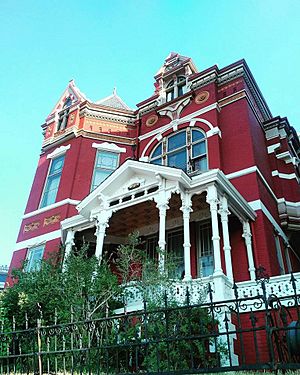
Butte has many museums and places that tell its history. In 2002, it was named one of only 12 "Distinctive Destinations" in the U.S. by the National Trust for Historic Preservation. The Butte Silver Bow Public Library works to save the town's history. It was started in 1894 to promote learning and show Butte as a cultured city. The Butte-Silver Bow Public Archives also keeps old documents and items from Butte's past.
Several museums focus on the city's mining history. These include the MBMG Mineral Museum on the Montana Tech campus. The World Museum of Mining is at the Orphan Girl mine in Uptown Butte. It has a fake mining town called "Hell Roarin' Gulch." The Berkeley Pit, a giant former open-pit copper mine, is also open for visitors to see.
Another interesting place is the Rookwood Speakeasy. It's a secret bar from the time when alcohol was illegal. It has an underground city area. The Mai Wah Museum works to save the history of Asian heritage in the Rocky Mountains.
The 34-room Copper King Mansion in Uptown Butte was built in 1884. It belonged to William A. Clark, one of the city's "Copper Kings." The mansion is now a bed-and-breakfast and a museum. Some people say it's haunted. The Art Chateau, once home to Clark's son, Charles, looks like a French château. It houses the Butte-Silver Bow Arts Foundation.
Above Butte, on the northeast side, is the Our Lady of the Rockies statue. It's a 90-foot tall statue of the Blessed Virgin Mary. It was placed there on December 17, 1985, after six years of building. Butte also has the U.S. High Altitude Speed Skating Center. It's an outdoor rink used by World Cup skaters for training.
All around Uptown and western Butte, you can see over ten old mine headframes. These are leftover from the mining industry. They include the Anselmo, the Steward, and the Original. As a community project, several headframes were repainted and lit up with LED lights at night.
Events and Traditions
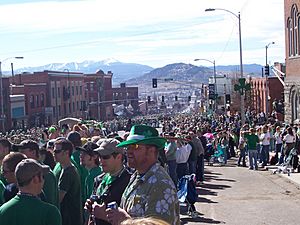
Butte has a long history with its Irish Catholic community. This is celebrated every year on St. Patrick's Day since 1882. About 30,000 people come to Butte's Uptown district for the parade. Also, people with Finnish roots celebrate St. Urho's Day every year on March 16.
A bigger yearly event is Evel Knievel Days. It's held on the last weekend of July and celebrates Evel Knievel, who was from Butte. This weekend event in Uptown Butte has stunt shows, sports, and live music.
Butte is also becoming known for the Montana Folk Festival. This free music festival happens on the second weekend in July. Butte also has an Fourth of July Parade and Fireworks show. In 2008, Barack Obama visited Butte for the Fourth of July before he became president.
Butte's immigrant history lives on in its local food. This includes the Cornish pasty, a meat pie that miners liked because it was easy to eat. There's also povitica, a Slavic nut bread, and the boneless porkchop sandwich. The Pekin Noodle Parlor in Uptown is the oldest Chinese restaurant in the U.S. that has been run by the same family.
Environmental Concerns
Berkeley Pit
After the Berkeley Pit mine closed in 1982, the pumps that kept water out were turned off. This caused the pit to slowly fill with groundwater, creating a lake. Just two years later, the pit was named a Superfund site. This means it's a very polluted area that needs cleaning up. The water in the pit has high levels of metals like arsenic, cadmium, and zinc.
Serious cleanup efforts for the Berkeley Pit didn't start until the 1990s. The problem became more urgent when 342 migrating geese died after landing in the pit lake. Now, steps are taken to prevent this from happening again. Loudspeakers broadcast sounds to scare away birds. In 2003, a water treatment plant started working. It treats and redirects much of the water that would flow into the pit.
The Berkeley Pit is both a Superfund site and a tourist attraction. You can view it from an observation deck. Scientists believe the pit's water might reach a critical level by 2023. This could contaminate Silver Bow Creek. In 2019, the Environmental Protection Agency ordered companies to start treating water from the pit. This treated water will then be released into Silver Bow Creek.
Upper Clark Fork River
The Upper Clark Fork River, which starts in Butte, is America's largest Superfund site. It stretches for 100 miles. This area includes Butte, Anaconda, and Missoula. Butte's mining and smelting activities caused a lot of pollution in the Butte Hill area and downstream.
The polluted land goes along a 120-mile corridor. It reaches to Milltown and includes the Anaconda smelter site. Contaminated dirt from old mines caused pollution at the start of the Clark Fork River.
Between Butte and Missoula is the Deer Lodge Valley. By the 1970s, people were worried about the toxic effects of arsenic and heavy metals on the environment and people's health. The Anaconda Copper Mining Corporation (ACM) was responsible for much of this pollution. In 1983, ACM stopped mining and smelting in the Butte-Anaconda area.
For over 100 years, the Anaconda Company mined ore from Butte and processed it. During this time, the Anaconda smelter released huge amounts of arsenic, sulfur, lead, and other heavy metals into the air. In Butte, mine waste was dumped directly into Silver Bow Creek. This created a 150-mile long trail of pollution down the valley. Air and water pollution also harmed farm animals and soil in the Deer Lodge Valley. Cleanup efforts are still happening today.
Butte's Sports
Butte has had several sports teams. The Butte Copper Kings played in the Pioneer Baseball League from 1979 to 1985, and again from 1987 to 2000. Today, the team is known as the Grand Junction Rockies. In 2017, the 3 Legends Stadium ballpark opened in Butte.
Hockey teams from Butte have included the Butte Irish (1996–2002) and the Butte Roughriders (2003–2011). The Butte Cobras played in the Western States Hockey League from 2014 to 2017. They later joined the North American 3 Hockey League (NA3HL) in 2018.
The Butte Daredevils basketball team (2006–2008) was named after Butte native Evel Knievel.
Montana Tech has sports teams called the Orediggers. They compete in the Frontier Conference of the NAIA. The school has men's and women's basketball, football, golf, and women's volleyball.
In October 2020, Butte was awarded a team in the Expedition League baseball league. They started playing in May 2021.
Getting Around Butte
Butte has a local bus system called Butte Bus. It operates within the city and goes to the Montana Tech campus and nearby Walkerville. You can also find intercity bus service from Jefferson Lines and Salt Lake Express. Bert Mooney Airport has commercial flights on Delta Connection Airlines.
You can reach Butte by car using Interstate 15 (north-south) and Interstate 90 (east-west). These two highways meet in Butte. Butte and Billings are the only cities in Montana where two interstate highways cross. You can also get to Butte from the south using Montana Highway 2.
The Union Pacific Railroad used to run a train called the Butte Special from Butte south to Salt Lake City until 1971. Until 1979, Butte was also served by Amtrak's North Coast Hiawatha train, which traveled from Chicago to Seattle.
Butte's Education
Butte Public Schools manages the elementary and high schools in Butte. There are also other school districts for nearby areas. Butte High School has about 1,300 students. The Butte Education Foundation was started in 2006 to help improve public schools. They believe good schools attract new businesses and residents.
Butte also has private schools. Butte Central Catholic High School and Butte Central Elementary are Catholic schools. The Silver Bow Montessori School is another private elementary school.
The first college in Butte was the Montana School of Mines, founded in 1889. It later changed its name to Montana Tech. In 1994, it became part of the University of Montana. The university is known for its engineering, geologic, and hydrogeologic research. In 2017, U.S. News & World Report ranked it highly for "Best Regional Colleges in the West." Montana Tech also has Highlands College, which offers two-year and trade degrees.
Butte's Media
Radio and Television
Major AM radio stations in Butte include KBOW AM 550 (country music) and KXTL 1370 (oldies and talk radio). FM stations include KFGL 88.1 (Christian music), KAPC 91.3 (Montana Public Radio), KAAR 92.5 (country), KOPR 94.1 (classic rock), KMBR 95.5 (mainstream rock), KQRV 96.9 (country), KGLM 97.7 (contemporary), KMSM-FM 103.9 (variety), and KBMF 102.5 (community radio with classical).
Butte shares its TV market with nearby Bozeman. Local TV stations include: KXLF (Channel 4), a CBS/CW channel and the oldest TV station in Montana; KTVM (Channel 6), an NBC channel; KUSM (Channel 9), a PBS channel; and KWYB (Channel 19), an ABC/FOX channel.
Newspapers
Butte has one daily newspaper, The Montana Standard. It was founded in 1928 when The Butte Miner and the Anaconda Standard combined. The Standard is owned by Lee Enterprises. The Butte Weekly is another local paper.
Famous People From Butte
Sister Cities
- Altensteig, Baden-Württemberg, Germany (since 1991)
- Bytom, Silesian Voivodeship, Poland (since 2001)
See also
 In Spanish: Butte (Montana) para niños
In Spanish: Butte (Montana) para niños




